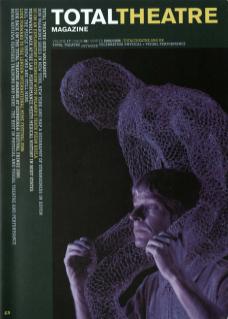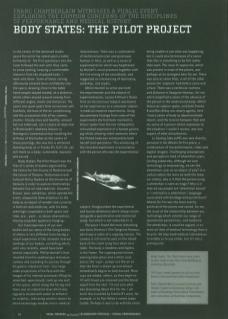In the centre of the darkened studio space the artist lay naked upon a table, brilliantly lit. The first spectators into the room followed the wall until they came to some seating, keeping a comfortable distance from the displayed body. I went with them. Some of those coming afterwards entered more confidently into the space, drawing close to the table. Some people stayed seated, at a distance, whilst others moved around viewing from different angles, levels and distances. The space was quiet apart from occasional soft footfalls, the hum of the air conditioning and the occasional click of my camera shutter. A body alive and healthy, relaxed but not etherised, not a corpse as depicted in Rembrandt's anatomy lessons or Mantegna's Lamentation but recalling the stillness of the bodies at the centre of those paintings. Nor was this a whitened bleeding body as in Franko B's Still Life, yet still there was a body; vulnerable, exposed, and sacred.
Body States: The Pilot Project was the first of a series of events organised by the Centre for the History of Medicine and the School of Theatre, Performance and Cultural Policy Studies at the University of Warwick in order to explore relationships between live art and medicine. Ansuman Biswas' auto-exhibition, which opened the event, eloquently drew attention to the body as an object of wonder and curiosity in both art and medicine, with his body seemingly suspended in both space and time, pre, post-, or above intervention, leaving unspoken questions hanging...
Our lived experience of our own bodies and our sense of the living bodies of others is very different from having a visual experience of the intimate internal workings of our bodies, something which, until very recently, would have been almost impossible. Phillip Warnell's Host resulted from his swallowing a miniature camera and recording its journey through his gastro-intestinal tract. Four large video projections of his face with the images of his internal processes filling his stretched-open mouth, took up one wall of the space, whilst along the facing wall there was an industrial laser which was regularly misted with water to enhance its visibility, indicating another means by which technology enables micro-medical interventions. There was a combination of technical precision and grotesque humour in Host, as well as a sense of experimentation which was heightened by Warnell's vocal presence together with the live mixing of the soundtrack, and suggested an intertwining of laboratory, workshop, and studio.
Whilst Warnell as artist was both the experimenter and the subject of experimentation, Louise K Wilson's Notes from an unconscious Subject was based on her experiences as a volunteer subject in medical research experiments. Using documentary footage from some of the experiments she had been involved in, Wilson spoke from the too infrequently articulated experience of a human guinea pig whilst allowing silent moments where the filmed body was witnessed by both herself and spectators. This witnessing of the recorded experiment in association with the person who was the experimental subject, foregrounded the experiential and human dimension which always exists alongside a quantitative and statistical study, but which is not reducible to it.
The piece I found the most disturbing was Anna Dimitriu's film Sanguine Humour which was a video of a cupping session. The camera is still and focuses on the naked back of the client lying face down on a table. The body is headless and legless in the frame. The cupping practitioner, wearing latex glove and a white coat, places the 'cups', pumps out the air so that the flesh is drawn up and almost immediately begins to look bruised. More cups are added, others, as they begin to fill with blood are removed and the blood wiped from the skin. I'm not sure what was disturbing about this for me. I am much less troubled by Franko B's work, for example, or by Ron Athey's recent Judas Cradle. Perhaps it was to do with the client being unable to see what was happening, but it could also be because of a sense that this is something to be felt rather than seen. The issue of voyeurism, which was present in most of the pieces, was perhaps at its strongest here for me. There was also as sense that, in all of the other pieces, the ‘subjects' had both a voice and a face. There was a technical coolness and distance in Sanguine Humour, for me, which amplified a sense of the absence of the person in the medicalised body. Whilst Wilson as subject spoke, and both Franko B and Ron Athey are clearly agents, here I had a sense of body as depersonalised object, and the tension between that and my sense of a person whose responses to the situation I couldn't access, was one aspect of what disturbed me.
Ju Gosling (aka Ju90) was very directly personal in her Wheels On Fire piece, a combination of live performance, video and digital imagery. Challenging assumptions and perceptions held of wheelchair users, Gosling asked why, although we view technology as empowering, we see the wheelchair-user as an object of pity? In a culture where the more we walk the lower our status, why is it that the person using a wheelchair is seen as tragic? Why is it that we say people are 'wheelchair bound or 'confined to a wheelchair', language associated with bondage and punishment? Wheels On Fire was the most overtly political of the pieces and raised, for me, the issue of the relationship between any technology which extends our range of operational possibilities, and medicine. The wheelchair, it could be argued, is no more an item of medical technology than a bicycle. We may need medical intervention to enable us to use either, but it's not a prerequisite.
Body States: The Pilot Project took place in June 2005 at the Ellen Terry Building in Coventry city centre.
See http://www.warwick.ac.uk/foc/arts/ history/chm/activitiesother/bodystates
Franc Chamberlain is lecturer in Drama and Theatre Studies at University College Cork, editor of Routledge Performance Practitioners, and a new series of Routledge Companions.

